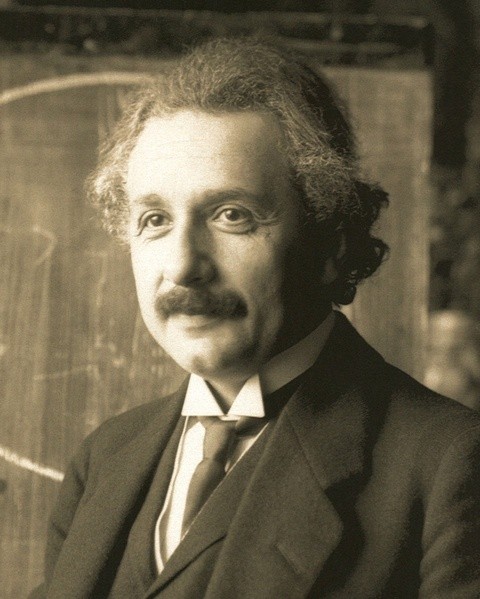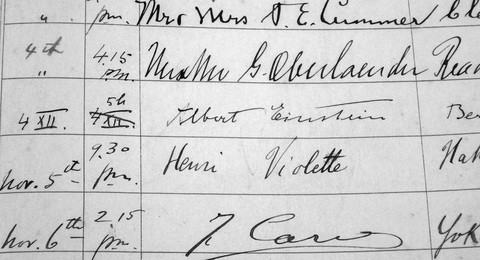59:宿泊者の記憶 / アインシュタイン --Memories of a guest / Albert Einstein-
金谷ホテルではお客様の宿泊記録である宿帳を保管しています。この宿帳は明治中期から昭和初期のもので、金谷ホテルの歴史そのものを記録した貴重な資料です。
Kanaya Hotel keeps guest ledgers that are records of guests' stays. These ledgers date from the mid-Meiji period to the early Showa period and are valuable documents that record the history of Kanaya Hotel itself.
今回は、これまでお迎えしてきた多くのお客様の中から、物理学者アルベルト・アインシュタインの日光滞在中のエピソードをご紹介します。
1922年(大正11年)11月、日本の出版社からの招聘を受けたアインシュタインは日本を訪れ、約1ヶ月半にわたって日本各地で講演しました。
ちなみに、この時日本へ向かう船上で11月9日にアインシュタインはノーベル物理学賞受賞の知らせを受けています。
講演旅行の旅程の中で日光を訪れたアインシュタインは金谷ホテルに夫人と共に宿泊しました。
日光滞在中の様子を、旅に同行していた石原純、岡本一平の著書に見ることができます。
Kanaya Hotel keeps guest ledgers that are records of guests' stays. These ledgers date from the mid-Meiji period to the early Showa period and are valuable documents that record the history of Kanaya Hotel itself.
This time, we will introduce an episode from the life of physicist Albert Einstein during his stay in Nikko, one of the many guests we have welcomed to date.
In November 1922 (Taisho 11), Einstein was invited by a Japanese publishing company to visit Japan, where he gave lectures throughout the country for about a month and a half. By the way, on November 9th, while on a ship bound for Japan, Einstein received the news that he had been awarded the Nobel Prize in Physics. Einstein visited Nikko during his lecture tour and stayed at the Kanaya Hotel with his wife.
Descriptions of their stay in Nikko can be found in the books written by Jun Ishihara and Ippei Okamoto, who accompanied him on the trip.
博士(アインシュタイン)は常に徒歩を好まれる。日光の町をホテル(金谷ホテル)まで歩くうち、特に博士が立ち停まったものを列記する。
一膳飯屋の鯛の看板。八百屋の大根。子供の羽根つき。銀行。
銀行の前ではわれらの耳に口を寄せて「日本の銀行の前にはきっと植木が植えてあるね」。
けだし、普通の外人には穿ち得ぬ微細な評である。
(金谷ホテルの)食卓に於ける博士は誠に素直で愉快なおじさんだ。夫人の選ぶ食べ物も黙って食べる。
上品で無邪気な冗談を連発する。
晩餐の卓へ博士は宇都宮名物玩具の小瓢箪を持って出た。
そしてその中へ水を入れ、面白そうに飲む。瓢箪で飲むのは酒呑みですよと言うと、わざと夫人の手前をはばかるような顔付を大袈裟にしてあわててポケットへしまい込む。
一同東照宮見物。まず貴賓館で宮司の説明を聴き、さて霊廟に入る。
あるお宮に巫女が坐っている。これが博士の好奇心を牽いた。彼女の労働時間を訊く。いわく8時間。巫女の労働時間を調べたのは奇抜だ。
鳴き龍というのが名高い。天井に描きある画龍の顔の直下に立って掌を拍くと、天井にてからからと鳴くのだ。
「音響の作用だろう」すこぶる簡単に済ます。
博士に対しては名物も価値変動を行わしめる。
(日光東照宮の)参拝の人を見て「この多くの人々は宗教心から詣るのか、見物のためか」と問いを出す。大部痛い問いである。
見物終わり門を出ると、一隊の女生徒を率いて小学校の先生が待ち受けていた。先生は直立不動の姿勢にて元気よき英語の暗誦口語「私ハ貴下ヲ見ル事ヲ悦ンデアルー」から始めた。
その間に博士は莞爾(かんじ)して自分の帽子を脱いで一人の生徒にかぶせたりして愛す。他の生徒達はドッと笑う。かぶされた生徒ははにかんで泣顔になる。
この女生は当分博士の帽子をかぶったことによって学校中の評判になろう。
「アインシュタイン講演録」(石原純・著/岡本一平・画)東京図書
※一部抜粋。一部括弧書きにて補足。
独特の視点で日光を訪れていたことが窺えて面白い記録ですね。
鳴き龍を物理の視点で感想を述べている点も「らしさ」があります。
The doctor (Einstein) always liked to walk. Here is a list of places he stopped at on his way to the hotel (Kanaya Hotel) through the town of Nikko.
A sea bream-shaped signboard at a restaurant. A radish at a greengrocer. A child playing shuttlecock. A bank.
In front of the bank, he would lean in close to our ears and say, "In Japan, there are potted plants always in front of banks."
However, it is a very subtle criticism that the average foreigner cannot grasp the essence of.
This is a comment on a trivial matter that most foreigners fail to appreciate.
At the dining table (at the Kanaya Hotel), the doctor is a truly honest and pleasant man. He eats the food his wife chooses in silence. He cracks a series of refined and innocent jokes. At the dinner table, the doctor brought a small gourd, a famous Utsunomiya toy. Then he pours water into it and drinks it, looking amused. When he is told that drinking from a gourd is supposed to be for alcohol, he makes an exaggerated, purposely embarrassed face in front of his wife, and hurriedly puts the gourd in his pocket.
We visited Toshogu Shrine. First we listened to an explanation from the chief priest at the guest house, then we entered the mausoleum.
A shrine maiden is sitting in a certain building. This piqued the doctor's curiosity. Ask about her working hours. She said it was eight hours. It was unusual to research the hours a shrine maiden worked.
"Nakiryu"(Roaring Dragon) is famous. If you stand directly under the painted dragon's face on the ceiling and clap your palms, the dragon will make a sound like a the dragon roar on the ceiling.
"It must be the acoustic effect," he explains very simply.
The doctor makes famous items change value.
(At Nikko Toshogu Shrine) the doctor saw people worshipping and asked me, "Are these many people there for religious reasons, or are they there for the sights?" This is a very painful question.
When we finished the tour and left the gate, a group of female students were waiting for us, led by an elementary school teacher. The teacher stood motionless and energetically recited a colloquial English phrase, "I am pleased to see you." Meanwhile, the professor is smiling and takes off his own hat and puts it on one of the students. The other students burst into laughter. The student who had the hat put on blushes and cries.
This girl will soon become famous throughout the school for wearing the professor's hat.
“Records of Einstein’s Lectures” (Author: Jun Ishihara/Illustrator: Ippei Okamoto) Tokyo Tosho
*Some excerpts. Some supplementary information in parentheses.
It's an interesting record that gives us a glimpse into the unique perspective he had when visiting Nikko.
It's also very "hilarious" that he comments on "Nakiryu"(Roaring Dragon) from a physics perspective.

